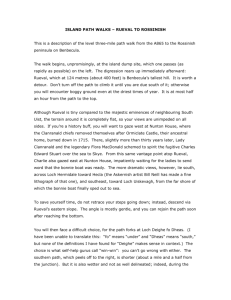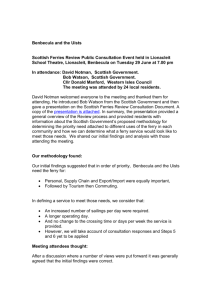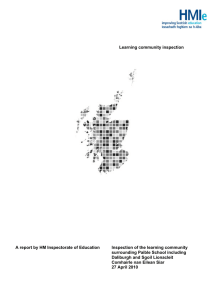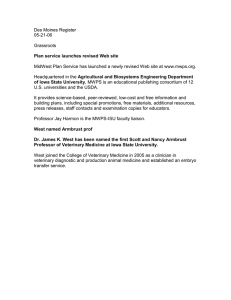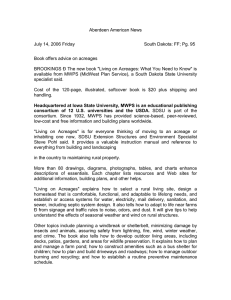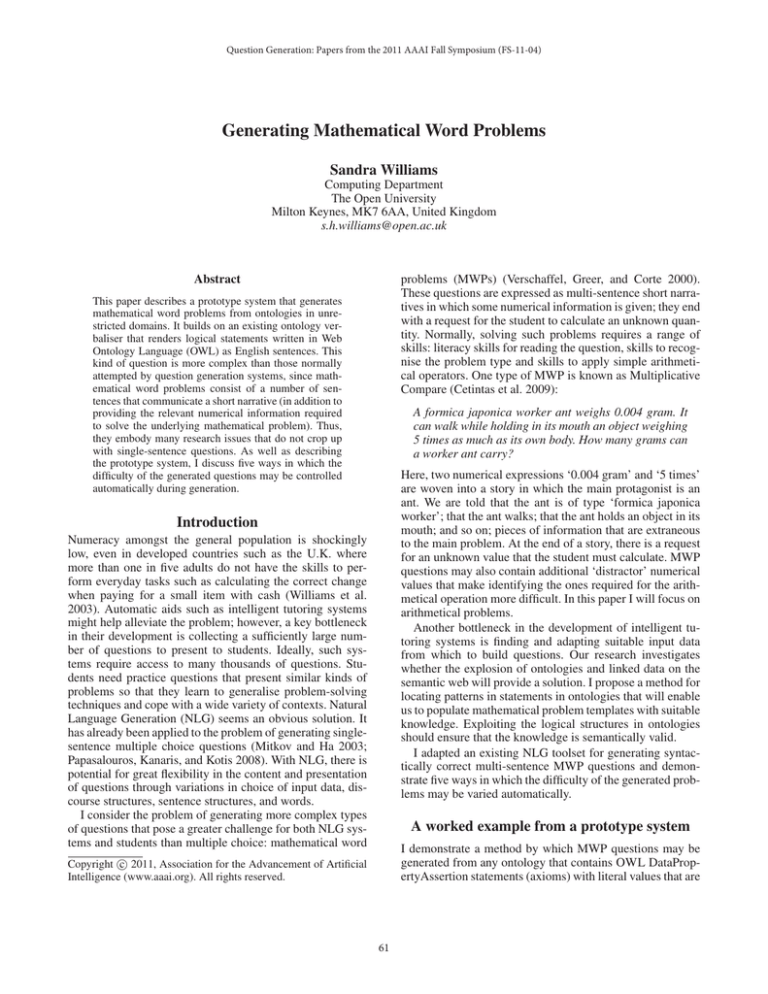
Question Generation: Papers from the 2011 AAAI Fall Symposium (FS-11-04)
Generating Mathematical Word Problems
Sandra Williams
Computing Department
The Open University
Milton Keynes, MK7 6AA, United Kingdom
s.h.williams@open.ac.uk
problems (MWPs) (Verschaffel, Greer, and Corte 2000).
These questions are expressed as multi-sentence short narratives in which some numerical information is given; they end
with a request for the student to calculate an unknown quantity. Normally, solving such problems requires a range of
skills: literacy skills for reading the question, skills to recognise the problem type and skills to apply simple arithmetical operators. One type of MWP is known as Multiplicative
Compare (Cetintas et al. 2009):
Abstract
This paper describes a prototype system that generates
mathematical word problems from ontologies in unrestricted domains. It builds on an existing ontology verbaliser that renders logical statements written in Web
Ontology Language (OWL) as English sentences. This
kind of question is more complex than those normally
attempted by question generation systems, since mathematical word problems consist of a number of sentences that communicate a short narrative (in addition to
providing the relevant numerical information required
to solve the underlying mathematical problem). Thus,
they embody many research issues that do not crop up
with single-sentence questions. As well as describing
the prototype system, I discuss five ways in which the
difficulty of the generated questions may be controlled
automatically during generation.
A formica japonica worker ant weighs 0.004 gram. It
can walk while holding in its mouth an object weighing
5 times as much as its own body. How many grams can
a worker ant carry?
Here, two numerical expressions ‘0.004 gram’ and ‘5 times’
are woven into a story in which the main protagonist is an
ant. We are told that the ant is of type ‘formica japonica
worker’; that the ant walks; that the ant holds an object in its
mouth; and so on; pieces of information that are extraneous
to the main problem. At the end of a story, there is a request
for an unknown value that the student must calculate. MWP
questions may also contain additional ‘distractor’ numerical
values that make identifying the ones required for the arithmetical operation more difficult. In this paper I will focus on
arithmetical problems.
Another bottleneck in the development of intelligent tutoring systems is finding and adapting suitable input data
from which to build questions. Our research investigates
whether the explosion of ontologies and linked data on the
semantic web will provide a solution. I propose a method for
locating patterns in statements in ontologies that will enable
us to populate mathematical problem templates with suitable
knowledge. Exploiting the logical structures in ontologies
should ensure that the knowledge is semantically valid.
I adapted an existing NLG toolset for generating syntactically correct multi-sentence MWP questions and demonstrate five ways in which the difficulty of the generated problems may be varied automatically.
Introduction
Numeracy amongst the general population is shockingly
low, even in developed countries such as the U.K. where
more than one in five adults do not have the skills to perform everyday tasks such as calculating the correct change
when paying for a small item with cash (Williams et al.
2003). Automatic aids such as intelligent tutoring systems
might help alleviate the problem; however, a key bottleneck
in their development is collecting a sufficiently large number of questions to present to students. Ideally, such systems require access to many thousands of questions. Students need practice questions that present similar kinds of
problems so that they learn to generalise problem-solving
techniques and cope with a wide variety of contexts. Natural
Language Generation (NLG) seems an obvious solution. It
has already been applied to the problem of generating singlesentence multiple choice questions (Mitkov and Ha 2003;
Papasalouros, Kanaris, and Kotis 2008). With NLG, there is
potential for great flexibility in the content and presentation
of questions through variations in choice of input data, discourse structures, sentence structures, and words.
I consider the problem of generating more complex types
of questions that pose a greater challenge for both NLG systems and students than multiple choice: mathematical word
A worked example from a prototype system
I demonstrate a method by which MWP questions may be
generated from any ontology that contains OWL DataPropertyAssertion statements (axioms) with literal values that are
c 2011, Association for the Advancement of Artificial
Copyright Intelligence (www.aaai.org). All rights reserved.
61
OWL statements
ClassAssertion(Class(#island) NamedIndividual(#benbecula))
ObjectPropertyAssertion(ObjectProperty(#memberOf)
NamedIndividual(#benbecula)
NamedIndividual(#uistAndBarraArchipelago))
DataPropertyAssertion(dataProperty(#hasPopulation)
NamedIndividual(#benbecula)
Literal(datatypeIRI=#integer 1219))
ClassAssertion(class(#island) NamedIndividual(#southUist))
ObjectPropertyAssertion(ObjectProperty(#memberOf)
NamedIndividual(#southUist)
NamedIndividual(#uistAndBarraArchipelago))
DataPropertyAssertion(DataProperty(#hasPopulation)
NamedIndividual(#southUist)
Literal(datatypeIRI=#integer 1818))
SWAT English sentences
Benbecula is an island
Benbecula is member of the Uist
and Barra Archipelago
Benbecula has a population of 1219
South Uist is an island
South Uist is member of the Uist
and Barra Archipelago
South Uist has a population of 1818
Table 1: OWL statements describing two individual that are comparable for MC problems.
defined as integers. For example, the travel ontology1 contains the following statement:
NamedIndividual(#benbecula)
Literal(DatatypeIRI=#integer 1219))
DataPropertyAssertion(
DataProperty(#hasPopulation)
NamedIndividual(#south_uist)
Literal(DatatypeIRI=#integer 1818))
What is the ratio of the two
<DataProperty(#hasPopulation)>?
DataPropertyAssertion(
DataProperty(#hasPopulation)
NamedIndividual(#benbecula)
Literal(DatatypeIRI=integer 1219))
This means that an individual, #benbecula has the data
property #hasPopulation with an integer value of 1219.
The first task is to locate two individuals in the ontology
that are similar enough to be compared in an MC problem.
We can define them as members of the same class, possessing the same data property with different values and
optionally sharing some additional property (not essential
since it merely provides ‘padding’ for the question). Table
1 (left column) shows OWL statements for two such individuals (Benbecula and South Uist) that are both members of the island class with different values for data property #hasPopulation and an additional shared property
#memberOf. The right-hand column shows English sentences produced by SWAT Tools (Stevens et al. 2010)2
which, amongst other things, derive lexical entries for each
identifier (e.g., #memberOf becomes the singular phrase ‘is
member of’ and the plural phrase ‘are members of’) and English sentences for each OWL statement.
The next tasks are to refactor and aggregate (Williams
and Power 2010) the retrieved OWL statements and arrange
them to form a MWP question, e.g.:
With some extensions to the SWAT Tools lexicon module
(improvement of lexical entries derived from data properties) and to the grammar (addition of a rule to produce a relative clause for the first statement), the first three OWL statements can be realised directly by the grammar. The final sentence is produced by slotting a noun phrase derived from the
lexical entry for the data property #hasPopulation into a
template. The output is then:
Benbecula and South Uist are islands that are members
of the Uists and Barra Archipelago. Benbecula has
a population of 1219. South Uist has a population of
1818. What is the ratio of the two populations?
Key factors affecting the difficulty of MWPs
There are a number of factors that affect the difficulty of
MWPs, some that can be controlled automatically within our
prototype question generator and others that have not yet
been tackled.
ClassAssertion(ObjectIntersectionOf(
Class(#Island)
ObjectHasValue(
ObjectProperty(#memberOf)
NamedIndividual(#uists_
and_barra_archipelago)))
[NamedIndividual(#benbecula)
NamedIndividual(#south_uist)])
DataPropertyAssertion(
DataProperty(#hasPopulation)
Factors that can be controlled automatically
In the prototype MWP question generation system, I have
identified some key factors that can be varied automatically:
1. Readability of the output text
2. Inclusion of distractor numerical values
3. Introduction of extranneous information into the narrative
4. Order of presentation of numerical values
1 The travel ontology is available from the TONES repository at
5. Conceptual difficulty of the mathematical problem
owl.cs.manchester.ac.uk/repository/
2 http://swat.open.ac.uk/tools/
Variations in any of these can affect the difficulty of a MWP.
62
The first, readability, can be increased by, for instance,
generating simple sentences and, conversely, decreased by
generating more complex ones. Sentence complexity is related to sentence length, a factor known to affect readability (Coleman 1962); indeed, it is a component of readability
formulae (Flesch 1949). Regarding the relationship between
readability and difficulty of MWPs, Wheeler and McNutt
(1983) found that low-achieving students performed significantly better on MWPs with simple sentences than on ones
with complex sentences. Sentence complexity can be controlled within our current generator by switching on or off
the aggregation and refactoring processes so that a version of
the MWP described above could be generated with shorter
sentences:
Thus, the system could generate a question that would be
easier from this point of view by requesting an addition calculation rather than a ratio:
Benbecula is an island. Benbecula has a population
of 1219. South Uist is an island. South Uist has a
population of 1818. What is the total population of the
two islands?
Other important factors for future research
Of course, there are other factors that control the difficulty
of MWPs that are outside the scope of the present work. For
example, a factor that has been discussed widely in the literature is authenticity (Palm 2009). MWPs are normally regarded as a means to teach students that abstract mathematical principles learnt in the classroom can be applied in real
world situations. If that is the aim, then the closer a MWP
models reality the better (i.e., the model should be ‘authentic’). Certain MWPs can then be criticised for anticipating
‘correct’ answers that are unrealistic, thus discouraging students from applying real problem solving techniques and instead coercing them to apply arithmetical operations in an
incorrect and formulaic manner; an example is the MWP:
Benbecula is an island. South Uist is an island. Benbecula is a member of the Uists and Barra Archipelago.
South Uist is a member of the Uists and Barra
Archipelago. Benbecula has a population of 1219.
South Uist has a population of 1818. What is the ratio of the two populations?
The second factor is distractor numerical values which are
often added to increase the difficulty of MWPs. Provided
that an ontology contains additional data properties relating
to the two named individuals, extra sentences with distractor
values can be generated, e.g.:
John’s best time to run 100 meters is 17 seconds. How
long will it take him to run 1 kilometer?
Benbecula has an area of 124.
where the so-called ‘correct’ answer, 170 seconds, clearly
does not reflect reality (Verschaffel, Greer, and Corte 2000).
Ideally, authenticity should be addressed, or at the very least,
non-authentic MWPs should be filtered out.
However, although this sentence reflects what is present in
the ontology, a unit of measurement for the land area is missing. Units were not present in the ontology and the present
system does not handle them (see Limitations).
The third factor, extraneous information, discussed in the
introduction, may be removed so that a question is simplified
by stripping it down to essentials, e.g.:
Limitations
The system is yet to be tested within a suitable intelligent
tutoring system and with users.
The current prototype is a proof-of-concept demonstrator
that has not been extensively tested on a large set of ontologies. Currently it generates only a few types of MWP (additions, subtractions, ratios). Of course, many more types
could be added and the natural language generator could be
more sophisticated. Currently, there is no handling of units
of measurement, for instance. Although some ontologies neglect to model these correctly (see the land area example
above), where they do, the system should be extended to
generate numerical quantities with units in English.
Benbecula has a population of 1219. South Uist has a
population of 1818. What is the ratio of the two populations?
The fourth factor is order of presentation of numerical
values. Cohen and Stover (1981) found that when asked
to modify MWPs for peers, students rearranged the order
of numerical values to facilitate mathematical operations. It
seems, then, that this ordering is at least perceived as playing
a role in question difficulty. In the MWP above, the smaller
population comes first which is the natural ordering for calculating a ratio, e.g., 2:3, but the reverse order would be
more natural for performing a subtraction. Of course, it is
easy to generate sentences in different orders to modify the
difficulty of a MWP.
The fifth factor, conceptual difficulty of the mathematical
problem, I address by consulting a mathematics curriculum
for schools (Qualification and Curriculum Authority 1999).
This builds on previous work (Williams and Power 2009) in
which we assumed that in basic skills mathematics courses,
concepts are taught in order of increasing difficulty. Thus
we view addition of single-digit numbers (taught at an early
stage) as simpler than calculating the ratio of two numbers
and giving the answer as a percentage (taught at later stage).
Conclusions
I have presented a prototype system for generating mathematical word problems (MWPs) from ontologies, a novel
application in the question generation community. I have
also identified and discussed five key factors that affect the
relative difficulty of these problems by drawing on research
from education and psychology that was carried out some
years ago. This has led to insights as to how these factors
might be addressed by simple means within the current prototype but there is much scope for further development, extensions to other kinds of MWP and, in particular, future
evaluations with mathematics teachers and students.
63
Acknowledgements
main Ontologies. In Nunes, M. B., and McPherson, M., eds.,
e-Learning, 427–434. IADIS.
Qualification and Curriculum Authority. 1999. Mathematics: the National Curriculum for England. Department for
Education and Employment, London.
Stevens, R.; Malone, J.; Williams, S.; and Power, R. 2010.
Automating class definitions from OWL to English. In Proceedings of Bio-Ontologies 2010: Semantic Applications in
Life Sciences SIG at the 18th Annual International Conference on Intelligent Systems for Molecular Biology (ISMB
2010).
Verschaffel, L.; Greer, B.; and Corte, D. E. 2000. Making
sense of word problems. Taylor and Francis.
Wheeler, L. J., and McNutt, G. 1983. The effect of syntax
on low-achieving students’ abilities to solve mathematical
word problems. 17(3):309–315.
Williams, S., and Power, R. 2009. Precision and mathematical form in first and subsequent mentions of numerical
facts and their relation to document structure. In Proceedings of the 12th European Workshop on Natural Language
Generation, 118–121.
Williams, S., and Power, R. 2010. Grouping axioms for
more coherent ontology descriptions. In 6th International
Natural Language Generation Conference (INLG 2010),
197–202.
Williams, J.; Clemens, S.; Oleinikova, K.; and Tarvin, K.
2003. The Skills for Life survey: A national needs and impact survey of literacy, numeracy and ICT skills. Technical
Report Research Report 490, Department for Education and
Skills.
I would like to thank my colleagues at The Open University
and the anonymous reviewers for their helpful suggestions
and comments. This research was supported the UK Engineering and Physical Sciences Research Council (EPSRC)
grants G033579/1 (Open University) and G032459/1 (University of Manchester).
References
Cetintas, S.; Si, L.; Xin, Y. P.; Zhang, D.; and Park, J. Y.
2009. Automatic text categorization of mathematical word
problems. In Proceedings of the 22nd International FLAIRS
Conference, 27–32.
Cohen, S. A., and Stover, G. 1981. Effects of teaching sixthgrade students to modify format variables of math word.
Reading Research Quarterly 16(2):175–200.
Coleman, E. 1962. Improving comprehensibility by shortening sentences. Journal of Applied Psychology 46:131–134.
Flesch, R. 1949. The Art of Readable Writing. Harper, USA.
Mitkov, R., and Ha, L. A. 2003. Computer-aided generation of multiple-choice tests. In Proceedings of the
HLT-NAACL 03 workshop on Building educational applications using natural language processing - Volume 2 (HLTNAACL-EDUC ’03), 17–22.
Palm, T. 2009. Theory of authentic task situations. In Verschaffel, L.; Greer, B.; Dooren, W. V.; and Mukhopadhyay,
S., eds., Words and Worlds: Modelling Verbal Descriptions
of Situations, 3–19. Sense Publishers.
Papasalouros, A.; Kanaris, K.; and Kotis, K. 2008. Automatic Generation Of Multiple Choice Questions From Do-
64

